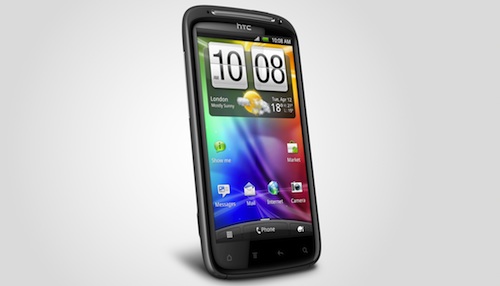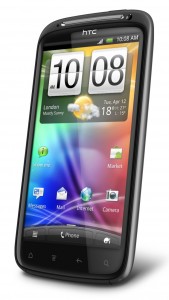
HTC’s long-awaited Sensation smartphone has finally begun shipping from SA’s mobile operators. The 4,3-inch touch screen device, which HTC has dubbed a “multimedia superphone”, has generated enormous interest since the Taiwanese manufacturer announced it a few months back. TechCentral has put the Sensation through its paces to find out if it matches up to the hype.
It’s inevitable that consumers will compare the Sensation to Samsung’s latest high-end Android-based smartphone, the Galaxy S II. The two handsets are, indeed, very similar: both have huge screens — the Samsung’s 4,3-inch Super Amoled Plus display is the brighter of the two, but the HTC device serves up a higher resolution. The Galaxy S II packs in 800×480 pixels, while the Sensation squeezes in a few more at 960×540 (it’s called qHD, and provides an aspect ratio of 16:9, which makes it great for watching movies).
Yes, the Amoled screen on the Samsung means it looks gorgeous at almost viewing angle and is easily readable in sunlight. But the higher resolution on the Sensation means the quality differences are minimal, especially indoors.
There are other similarities between the two devices. Both run Android 2.3 — our Sensation ships with 2.3.3 — and both have 8-megapixel rear-facing cameras capable of shooting full high-definition video. They also both ship with snappy dual-core processors. The HTC has dual LED flash, while the Samsung has only one flash, but the latter has a better front-facing camera: 2-megapixels vs a low-quality VGA snapper on the former.
The Sensation is also somewhat heavier than the Galaxy S II — 148g vs 116g — though the it’s far from being uncomfortably heavy. It’s slightly greater heft actually makes the device feel a little more robust in the hand. Remarkably, the Sensation doesn’t feel like a big phone, despite its enormous screen real estate. It feels smaller than the Galaxy.
The Sensation is HTC’s latest top-end smartphone, so it includes everything you’d expect in such a device: the latest HSPA broadband technology (900MHz 3G included) for downloads of up to 14,4Mbit/s, Wi-Fi (in the b, g and n variants), an internal GPS antenna, Bluetooth 3.0, DLNA for wirelessly streaming media to a supported PC or TV, as well as HDMI output through the micro USB port (adapter not included). There’s a gyro-sensor, digital compass and proximity and ambient sensors.
There’s also 1GB of internal storage and 768MB of RAM. This seems terribly stingy next to the Samsung’s 16GB or 32GB of storage, but the Sensation does ship with an 8GB SD card as standard. Still, we’d have liked to have seen more capacity built into the device. HTC probably left it out to keep the Sensation’s price in check — at a recommended retail price of about R5 300, the device is well priced for what it delivers and about two grand cheaper than the Galaxy S II.
In terms of design, the Sensation is arguably the best looking handset HTC has made to date. Encased in an aluminium shell, it will certainly turn heads. Even die-hard Apple iPhone fans will want to take a closer look at one if it’s left on a desk or coffee table.

There’s a slick elongated earpiece across the top of the phone, with the 8-megapixel shooter positioned to its right. At the bottom are four touch-sensitive buttons and on the left side is a generously sized volume rocker and the USB/HDMI port through which the device is also charged. The top of the phone has the power on/off button and a 3,5mm headphone jack, while the right-hand side is left free of any obstructions. A single speaker grille and the camera and LED flashes are located at the top of the rear of the phone. All in all, it’s a polished design that makes it a pleasure to hold and to use. Our only gripe is that figuring out how to take the back cover off to insert a Sim card takes a little effort.
The built-in camera produces good pictures and video quality is fantastic. The camera software offers a surprisingly wide range of options to improve photos on the fly. And the time it takes from firing up the app to taking a snap is best in class. On the Desire, by way of comparison, it was frustratingly slow — by the time the app was ready to shoot a pic, the subject had often moved on. Though it can’t be compared to a dedicated HD video camera, the 1080p video shot by the Sensation certainly can’t be quibbled at.
Where we think the Sensation really shines, especially next to the Galaxy S II, is in its user interface. Using the latest version of HTC’s Sense software for Android — version 3.0 — the Sensation offers plenty of gorgeous eye candy. Of course, Sense has its detractors, too, but we think it’s one of HTC’s strongest selling points. When the screen is woken, users can drag preselected icons into a circle at the bottom of the screen for instant access. Or they can swipe the circle up for full access to the user interface.
As with many other Android-based HTCs, the Sensation has a generous seven home screens, which can be personalised to the users’ desire. The new Sense UI also takes advantage of the powerful dual-core processor to offer up delightful 3D animations — flipping between screens, for example, creates a pleasing 3D rotation effect. Of course, the animations can be reduced or switched off entirely for those wanting to eke out extra battery power. On the downside, though, the Sensation’s interface doesn’t feel quite as snappy as the Galaxy S II’s. Don’t get us wrong: it’s still blazingly fast, but it’s not as quick as the Samsung.
Battery life deserves a special mention. Though slightly smaller than the one found in the older HTC Desire, the Sensation’s battery appears to last about the same amount of time. We haven’t had the time yet to put the 1 520mAh battery through its paces, but for a device with such a large screen it is remarkably frugal when it comes to energy consumption. Of course, with moderate to heavy use, you can still expect to have to charge it once a day. And if you’re using it to shoot video, especially at 1080p, or watch movies, then you’d better pack the charger in your bag.
Multimedia playback on the Sensation is exceptional. The high resolution of the screen and its 16:9 format make it ideal as an entertainment device (it is called a multimedia superphone, so we’d expect nothing less), though the built-in speaker could have been better. It’s a little tinny, and you’ll want to plug in headphones for a more immersive experience.
In summary
The Sensation is the best phone HTC has made to date. Whether that also makes it the best phone on the market is open to debate, though surely it comes close. Ultimately, this phone will be matched up against the more expensive Galaxy S II. Would we recommend this over the Samsung. Based on the Sense UI, which we prefer to Samsung’s TouchWiz interface, we’d say yes. But it’s true that the Korean handset offers a better screen, especially in bright conditions, albeit at a lower resolution. The Galaxy also has oodles of on-board storage, but at a higher price.
If you’re in the market for a high-end, large-screen Android smartphone, the Sensation and the Galaxy S II are both worth considering. Both are top quality phones with few faults and plenty going for them. On personal preference alone, we’d choose the Sensation. But that doesn’t mean the Samsung is in any way the inferior product. — Duncan McLeod, TechCentral
- See also: Samsung Galaxy S II: bold and beautiful
- Subscribe to our free daily newsletter
- Follow us on Twitter or on Facebook




